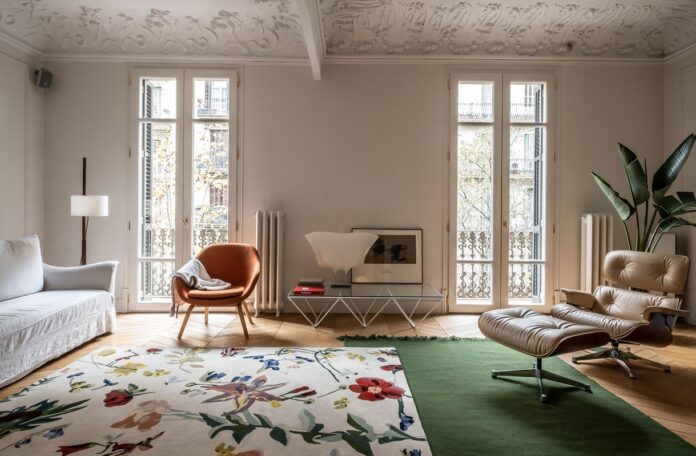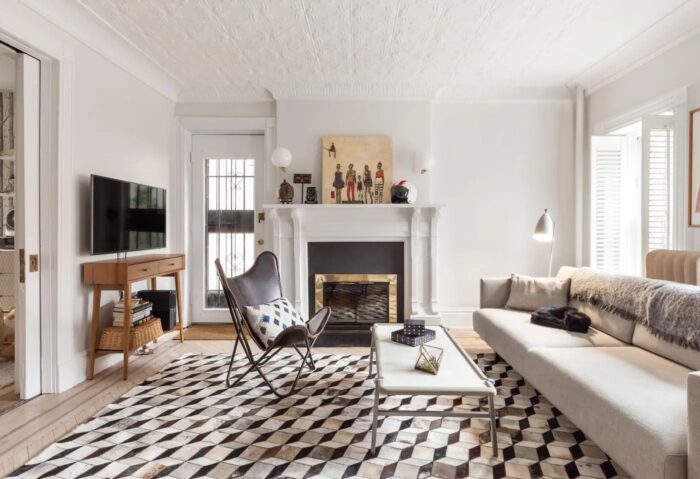
Area rugs are versatile design elements that can greatly enhance the overall aesthetic of a room. Here are some basics to understand about area rugs and their impact on room design:
- Definition and Purpose: Area rugs are large floor coverings that anchor furniture groupings, define spaces, and add warmth and texture to a room. They serve functional and aesthetic purposes.
- Size and Placement: The size of the rug should be determined by the dimensions of the room and the furniture layout. Ideally, the rug should be large enough for the key furniture pieces to sit on it or at least have their front legs on the rug.
- Design and Style: They come in a variety of designs, patterns, and styles to complement different interior aesthetics. They can be used to add a pop of color, introduce patterns, or create visual interest in a room.
- Texture and Material: The texture and material of the rug impact the overall feel of the space. For example, a plush, shaggy rug adds coziness, while a flatweave rug offers a more casual and streamlined look. Consider the material’s durability and maintenance requirements.
- Room Coordination: It can tie together the various elements in a room, such as furniture, artwork, and accessories. They can unify the color palette and create a cohesive visual flow.
- Practical Considerations: Choose rugs that are easy to clean and maintain, especially in high-traffic areas or if you have pets or children. Consider rug pads to prevent slipping and provide extra cushioning.
Select large rugs for the living room that fits with your home’s style aesthetic

When selecting large rugs for the living room, it’s crucial to choose one that aligns with your home’s style aesthetic. Here’s why:
- Coherence: The rug should contribute to a cohesive design scheme. Consider the existing style of your living room, whether it’s modern, traditional, bohemian, or transitional. Look for a rug that complements the overall aesthetic and enhances the desired ambiance.
- Color and Pattern: Choose a rug with colors and patterns that harmonize with the existing color palette and decor in your living room. Opt for complementary or contrasting colors, depending on the desired effect. Patterns can provide the room texture and aesthetic interest.
- Material and Texture: Consider the material and texture of the rug in relation to the overall style of the room. For example, a plush, high-pile rug may suit a cozy and traditional setting, while a sleek, low-pile rug could work well in a modern or minimalist space.
- Size and Placement: Ensure the rug is large enough to accommodate the main furniture pieces, such as the sofa and coffee table, while leaving enough space around the edges. The placement of the rug should create a balanced and inviting arrangement.
Choose the right big sized rugs for the floor you are working with
Choosing the right big sized rugs for the floor you are working with is crucial for creating a harmonious and visually pleasing space. Consider the following factors:
- Room Size: Determine the dimensions of the room and identify the available floor space. This will help you determine the appropriate size for the rug. Aim for a rug that fills the room without overwhelming it or appearing too small.
- Furniture Layout: Take into account the furniture placement and arrangement in the room. The rug should be large enough to anchor the furniture or at least have the front legs of the main pieces resting on it. Ensure the rug extends beyond the furniture to create a cohesive and inviting space.
- Floor Type: Take into account the type of flooring you have. If you have hardwood or tile floors, a larger rug can help provide warmth and comfort. If you have carpeting, ensure the rug’s size and thickness do not cause it to bunch up or create a tripping hazard.
- Style and Design: Select the right one that aligns with the style and design of the room. Consider the color, pattern, and texture of the rug in relation to the existing decor. The rug should complement the overall aesthetic and enhance the ambiance of the space.
Use accessories like pillows and throws to tie the design together with rug

Using accessories like pillows and throws is a fantastic way to tie the design together with a rug. Here’s why:
- Color Coordination: Select pillows and throws that incorporate colors found in the rug. This creates a cohesive and unified color palette, enhancing the overall design of the space. Choose complementary or matching hues to create a harmonious look.
- Pattern Play: Consider incorporating patterns in pillows and throws that complement or echo the patterns in the rug. This adds visual interest and creates a sense of cohesion. Mix patterns of different scales to create a dynamic and layered look.
- Texture and Fabric: Experiment with different textures and fabrics in pillows and throws to add depth and tactile appeal. Contrast the textures of the accessories with the rug to create an interesting visual and sensory experience in the room.
- Balance and Proportion: Arrange the pillows and throws strategically to create a balanced and proportionate composition. Place larger pillows at the back and smaller ones at the front, and layer throws casually over furniture for an inviting and relaxed feel.
- Style and Theme: Consider the style and theme of the room when selecting accessories. Choose pillows and throws that align with the overall aesthetic, whether it’s modern, bohemian, traditional, or eclectic.

Conclusion
Large area rugs are powerful design elements that can tie together your home’s design. By considering factors such as size, shape, color, and texture, you can select the right rug that complements the space. Additionally, using accessories like pillows and throws that coordinate with the rug further enhances the overall design cohesion.
















